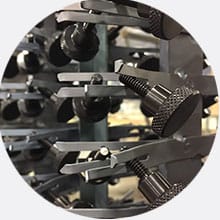Anodizing
Durable Anodizing Finishes
Anodizing creates a decorative, durable, corrosion-resistant anodic oxide finish by converting the metal surface of an aluminum alloy. This aluminum oxide layer is not applied to the surface like paint or plating, it originates from the metal substrate and is composed entirely of aluminum oxide, so it cannot chip or peel.
The aluminum oxide finish is highly porous. That means when a substrate needs a secondary process, such as coloring and sealing, the aluminum oxide finish provides an effective primary base for the next process. During the anodizing process, we immerse the aluminum into an acid electrolyte bath and pass an electric current through the medium.
ECO FINISHING OFFERS TWO TYPES OF ANODIZING FINISHES:
TYPE II (regular) sulfuric anodizing
TYPE III Hardcoat sulfuric anodizing,
which is accomplished at a lower temperature and higher current density than Type II.
Both finishes are very hard, but Type III is much thicker than Type II. When your substrate is prone to scratching or experiences heavy wear, Type III provides increased protection.
How The Oxide Layer Works
The oxide layer is a combination of buildup on the surface of the aluminum part and penetration into the metal. The surface of the parts recedes dimensionally as the aluminum outer layer converts into aluminum oxide. The aluminum oxide layer grows faster than the metal base recedes, thus adding thickness to the surfaces.
Roughly, it is estimated that 50% of the coating thickness (the oxide layer) in type III hardcoat anodizing corresponds to penetration and 50% to buildup, whereas these values are approximately 67%/33% for type II anodizing, respectively.





